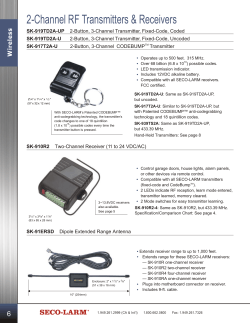
VERSATILE TIME-DOMAIN ELECTROMAGNETIC SYSTEM
V TEM ™ plus VERSATILE TIME-DOMAIN ELECTROMAGNETIC SYSTEM Geotech’s exclusive and industry-leading VTEM™ (Versatile Time-Domain Electromagnetic) system has surveyed more than two million line-kilometres with confirmed results in many different deposits and host geologies for various industries. We operate more than 30 VTEM™ systems globally. VTEM™ plus VERSATILE TIME-DOMAIN ELECTROMAGNETIC SYSTEM FEATURES • Highest signal to noise ratio in the industry providing superior depth of investigation • In-loop transmitter-receiver geometry to provide a symmetric response to allow for intuitive conductor interpretation • Low noise receiver and in-loop transmitter-receiver geometry provides for high spatial resolution • Low base operating frequency - standard is 30 Hz or 25 Hz to penetrate through conductive overburden • Long on-pulse and B-field data to detect and resolve high conductance targets • Easily deployable to all parts of the world VTEM™ plus WITH OPTIONAL MAGNETIC GRADIOMETER • Two Geometrics split-beam total field magnetic sensors, with a sampling interval of 0.1 seconds located 10 m above the transmitter loop • Horizontal separation between two magnetic sensors is 12.5 m • Second GPS antenna and inclinometer at 10 m above the transmitter loop BENEFITS VTEM™ plus is the leading time-domain electromagnetic system in the world. At the beginning of 2010, 30 systems were available worldwide. The coincident, vertical dipole transmitter-receiver configuration provides a symmetric system response. Any asymmetry in the measured EM profile is due to conductor dip, not the system or direction of flying. This allows for easy identification of the conductor location and for interpretation of the EM data. The low noise receiver, plus the high power transmitter yields a system that has the best signal to noise ratio of any airborne system. VTEM™ plus has been designed to detect and discriminate between moderate to excelent conductors using a low base frequency, long pulse width, and derived B-field. The B-field is derived from integrating data collected at 192 kHz over the entire waveform. The system is easily disassembled into small enough pieces to be shipped using standard containers. Geotech maintains an inventory of spare parts to ensure the system can be repaired easily in the field. Americas www.geotech.ca sales@geotech.ca International www.geotechairborne.com sales@geotechairborne.com Offices Australia Brazil Barbados Canada Chile Ghana Kazakhstan Russia South Africa An example of VTEM™ dB/dt and B-field data is shown. It can be seen that the B-field data responds to the better conductors and that the overburden response is supressed. This allows for easier interpretation of bedrock EM anomalies. The high signal to noise ratio of the system is also seen above. TRANSMITTER Transmitter-receiver geometry In-loop, vertical dipole Transmitter coil Dodecagon shape-vertical axis, 540m² Base frequency Standard 30 Hz or 25 Hz depending on powerline frequency Pulse shape Polygonal Pulse width Typically 43% of the half cycle over 7 ms in length Peak dipole moment Up to 625,000 NIA (400,000 typical) Peak current Up to 310 Amperes (200 typical) RECEIVER Coils Standard Z,X, optional Y Sample rate 192 kHz over entire waveform Bandwidth Up to 50 kHz Spheric noise rejection Digitial Industrial noise rejection 60 Hz or 50 Hz MECHANICAL Nominal survey speed 90 km/hr EM transmitter/receiver ground clearance 30 m Operating temperature -45 ̊ C to 45 ̊ C Power requirements From helicopter, auxiliary power not required Shipping Standard packaging (longest piece - 2.5 m) Installation/assembly time One day typically
© Copyright 2025











